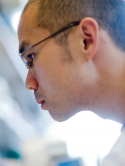Development of a second-generation antiandrogen for treatment of advanced prostate cancer Journal Article
| Authors: | Tran, C.; Ouk, S.; Clegg, N. J.; Chen, Y.; Watson, P. A.; Arora, V.; Wongvipat, J.; Smith-Jones, P. M.; Yoo, D.; Kwon, A.; Wasielewska, T.; Welsbie, D.; Chen, C. D.; Higano, C. S.; Beer, T. M.; Hung, D. T.; Scher, H. I.; Jung, M. E.; Sawyers, C. L. |
| Article Title: | Development of a second-generation antiandrogen for treatment of advanced prostate cancer |
| Abstract: | Metastatic prostate cancer is treated with drugs that antagonize androgen action, but most patients progress to a more aggressive form of the disease called castration-resistant prostate cancer, driven by elevated expression of the androgen receptor. Here we characterize the diarylthiohydantoins RD162 and MDV3100, two compounds optimized from a screen for nonsteroidal antiandrogens that retain activity in the setting of increased androgen receptor expression. Both compounds bind to the androgen receptor with greater relative affinity than the clinically used antiandrogen bicalutamide, reduce the efficiency of its nuclear translocation, and impair both DNA binding to androgen response elements and recruitment of coactivators. RD162 and MDV3100 are orally available and induce tumor regression in mouse models of castration-resistant human prostate cancer. Of the first 30 patients treated with MDV3100 in a Phase I/II clinical trial, 13 of 30 (43%) showed sustained declines (by >50%) in serum concentrations of prostate-specific antigen, a biomarker of prostate cancer. These compounds thus appear to be promising candidates for treatment of advanced prostate cancer. |
| Keywords: | controlled study; protein expression; unclassified drug; human cell; genetics; androgen; clinical trial; advanced cancer; dose response; nonhuman; antineoplastic agents; antineoplastic agent; binding affinity; cell proliferation; prostate specific antigen; protein blood level; mouse; animal; metabolism; animals; mice; animal tissue; phase 2 clinical trial; gene expression; animal experiment; animal model; genetic transcription; transcription, genetic; antineoplastic activity; drug structure; drug effect; drug screening; pathology; drug screening assays, antitumor; xenograft model antitumor assays; cell line, tumor; drug specificity; drug receptor binding; prostate cancer; prostatic neoplasms; gene expression regulation; gene expression regulation, neoplastic; chemistry; dna; drug mechanism; biomarker; prostate tumor; tumor cell line; androgen antagonists; drug derivative; single drug dose; cellular distribution; androgen receptor; drug bioavailability; cell nucleus; phase 1 clinical trial; antiandrogen; bicalutamide; mdv 3100; receptors, androgen; drug half life; tumor; dna binding; regression analysis; drug protein binding; anilides; nitriles; tosyl compounds; nitrile; bioavailability; biological availability; disease treatment; anilide; toluenesulfonic acid derivative; metribolone; rd 162; ru 59063; thiohydantoin derivative; phenylthiohydantoin; rd162 compound; concentration (composition) |
| Journal Title: | Science |
| Volume: | 324 |
| Issue: | 5928 |
| ISSN: | 0036-8075 |
| Publisher: | American Association for the Advancement of Science |
| Date Published: | 2009-05-08 |
| Start Page: | 787 |
| End Page: | 790 |
| Language: | English |
| PROVIDER: | scopus |
| PMCID: | PMC2981508 |
| PUBMED: | 19359544 |
| DOI: | 10.1126/science.1168175 |
| DOI/URL: | |
| Notes: | --- - "Cited By (since 1996): 197" - "Export Date: 14 February 2012" - "Source: Scopus" |
Altmetric
Citation Impact
BMJ Impact Analytics
MSK Authors
Related MSK Work










